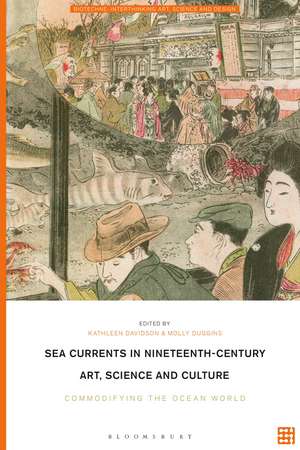Sea Currents in Nineteenth-Century Art, Science and Culture: Commodifying the Ocean World: Biotechne: Interthinking Art, Science and Design
Editat de Dr Kathleen Davidson, Molly Dugginsen Limba Engleză Hardback – 8 mar 2023
Preț: 547.07 lei
Preț vechi: 777.97 lei
-30% Nou
Puncte Express: 821
Preț estimativ în valută:
104.69€ • 113.68$ • 87.94£
104.69€ • 113.68$ • 87.94£
Carte disponibilă
Livrare economică 02-16 aprilie
Livrare express 18-22 martie pentru 134.03 lei
Preluare comenzi: 021 569.72.76
Specificații
ISBN-13: 9781501352782
ISBN-10: 1501352784
Pagini: 336
Ilustrații: 27 colour & 53 bw illus
Dimensiuni: 156 x 234 x 28 mm
Greutate: 0.92 kg
Editura: Bloomsbury Publishing
Colecția Bloomsbury Visual Arts
Seria Biotechne: Interthinking Art, Science and Design
Locul publicării:New York, United States
ISBN-10: 1501352784
Pagini: 336
Ilustrații: 27 colour & 53 bw illus
Dimensiuni: 156 x 234 x 28 mm
Greutate: 0.92 kg
Editura: Bloomsbury Publishing
Colecția Bloomsbury Visual Arts
Seria Biotechne: Interthinking Art, Science and Design
Locul publicării:New York, United States
Caracteristici
Views the Atlantic, Indian, and Pacific Ocean worlds through the lens of nineteenth-century imperialism, highlighting heretofore unpublished international research as well as rare material from collections and archives
Notă biografică
Kathleen Davidson is a Postdoctoral Research Fellow in the Department of Art History at the University of Sydney, Australia. Molly Duggins is a lecturer in the Department of Art History and Theory at the National Art School, Sydney, Australia.
Cuprins
List of IllustrationsList of ContributorsAcknowledgements1. Commodifying the Ocean World in the Long Nineteenth Century, Kathleen Davidson and Molly Duggins (The University of Sydney, Australia; National Art School, Sydney, Australia)Part One: Wave - Circulating Marine Products2. Ambergris in Eighteenth- and Nineteenth-Century Medicine, Perfume and Natural History, Georgina Cole (National Art School, Sydney, Australia)3. Imperial Coral: The Transformation of a Natural Material to a Qing Imperial Treasure, Pippa Lacey (National Maritime Museum, Greenwich, UK)4. Echoes of Empire: The Painted Museums of Leroy de Barde, Jessica Priebe (the National Art School, Sydney, Australia)5. 'Native Manufactures': Sailors' Valentines and the Caribbean Curio Trade, Molly Duggins (the National Art School, Sydney, Australia)Part Two: Shore - Coastal Economies and Ecologies6. Reading the Wrack Line on the French Atlantic Shore, Maura Coughlin (Bryant University in Smithfield, Rhode Island, USA)7. An Intense Curiosity: Marine Research Stations and Marine Specimens in the Late Nineteenth Century, Jude Philp (Macleay Museum, The University of Sydney, Australia)8. The Tears of Pearls: Archaic Labour, Fisheries and Waste in Ceylon and Beyond, Natasha Eaton (UCL, UK)9. Culture Keeping and Money Making: Aboriginal Women's Shellwork from the South Coast of New South Wales, Priya Vaughan (the National Art School, Sydney, Australia)Part Three: Seabed - Materializing Submarine Environments 10. Their 'Colours are Brilliant, but Fugitive': Coral Concerns from Imperial Expeditions and the British Museum to the Royal Academy and Drury Lane, Kathleen Davidson (The University of Sydney, Australia)11. Aquariums Under the Rising Sun: A Cultural History of Early Public Aquariums in Japan, 1882-1903, Yuichi Mizoi (Kansai University, Japan)12. Merging the University Museum and Volksbildung: The Curatorial Strategies of Berlin's Museum für Meereskunde in 1900, Stefanie Lenk (The University of Göttingen, Germany) Part Four: Oceanic Objects - Museum Case Studies13. 'An Imitation of Seaweed': Nature and Design in a Late Eighteenth-Century Printed Cotton, Ann Christie (Independent Researcher)14. Fashioning Whale Bone: Scrimshaw and the Nineteenth-Century Tradition of the Decorative Busk, Martha Cattell (Curator and Independent Researcher)15. The Ornamental Glass Window of the Maison des Océans in Paris: A Celebration of Evolution, Jacqueline Goy (The Oceanographic Institute, Monaco) and Robert Calcagno (Government Advisor, Ministry of the Equipment, Environment and Urban Planning, Monaco)16. Trade Connections: The Acquisition of Blaschka Models of Marine Invertebrates by Museums in Australia and New Zealand, Jan Brazier, Curator of History, Macleay Collections, Chau Chak Wing Museum (The University of Sydney, Australia)BibliographyIndex
Recenzii
Sea Currents expands our thinking about human interactions with the oceans, linking developments in museums, consumerism, exploration, and colonialism with artistic and scientific culture, in an engaging discussion of how the ocean world was commodified by and for diverse communities.
The sea's leavings - whalebone, spermaceti, isinglass, mother-of-pearl, coral, seaweed - fascinate and allure. Exploring how nineteenth-century oceanic commodities were desired, extracted, displayed, and sold around the world, this volume provides a fascinating portrait of the Victorian sea and its global meanings.
Sea Currents moves beyond sublime seascapes and shipwrecks to uncover marine object and display histories and the myriad ways they infiltrated everyday life. From rich and strange to domesticated, here the sea not only exceeds the frame but blows it apart.
Sea Currents forwards an important intervention for historians to consider the oceans beyond their conventional treatment as surfaces or metaphors...In light of this lacuna in historiography, Sea Currents offers an elaborate collection of histories that recognizes both the material and metaphorical seas.
The sea's leavings - whalebone, spermaceti, isinglass, mother-of-pearl, coral, seaweed - fascinate and allure. Exploring how nineteenth-century oceanic commodities were desired, extracted, displayed, and sold around the world, this volume provides a fascinating portrait of the Victorian sea and its global meanings.
Sea Currents moves beyond sublime seascapes and shipwrecks to uncover marine object and display histories and the myriad ways they infiltrated everyday life. From rich and strange to domesticated, here the sea not only exceeds the frame but blows it apart.
Sea Currents forwards an important intervention for historians to consider the oceans beyond their conventional treatment as surfaces or metaphors...In light of this lacuna in historiography, Sea Currents offers an elaborate collection of histories that recognizes both the material and metaphorical seas.







